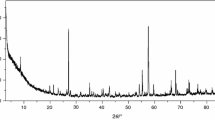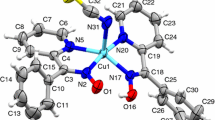Abstract
The thermal behavior of [Ca(H2O)3(2,3-pydcH)2] n (I), [Cd(H2O)3(2,3-pydc)] n (II), and [Cd(H2O)6][Cd(2,3-pydcH)3]2 (III) complexes with pyridine-2,3-dicarboxylic acid was monitored by TG, DTG, and DSC analysis, where 2,3-pydcH—mono deprotonated pyridine-2,3-dicarboxylic acid and 2,3-pydc—doubly deprotonated dicarboxylate anion. Thermal decomposition of these compounds go through one or two dehydratation stages, followed by the loss of organic matter. The final decomposition products are found to be the corresponding metal oxides. The possible scheme of destruction of the complexes have been used to reveal the relationships between stability and molecular structure.








Similar content being viewed by others
References
Berglund M, Akesson A, Bjellerup P, Vahter M. Metal–bone interactions. Toxicol Lett. 2000;112–113:219–25.
Järup L, Alfvén T. Low level cadmium exposure, renal and bone effects—the OSCAR study. Biometals. 2004;17:505–9.
Kazantis G. Cadmium, osteoporosis and calcium metabolism. Biometals. 2004;17:493–8.
Yocum ChF. The calcium and chloride requirements of the O2 evolving complex. Coord Chem Rev. 2008;252:296–305.
Marelli A, Russelet E, Dycke C, Bouron A, Moulis JM. Cadmium toxicity in animal cells by interference with essential metals. Biochimie. 2006;88:1807–14.
Iwahashi H, Kawamori H, Fukudhima K. Quinolinic acid, α-picolinic acid, fusaric acid, and 2,6-pyridinedicarboxylic acid enhance the Fenton reaction in phosphate buffer. Chem Bio Interact. 1999;118:201–15.
Suga T, Okabe N. Bis(pyridine-2,3-dicarboxylato-N,O)copper(II). Acta Crystallogr. 1996;Sect. C52:1410–2.
Patrick BO, Stevens CL, Storr A, Thompson RC. Structural and magnetic properties of three copper(II) pyridine-2,3-dicarboxylate coordination polymers incorporating the same chain motif. Polyhedron. 2003;22:3025–35.
Okabe N, Miura J, Shimosaki A. A hydrated cobalt(II) complex of quinolinic acid: trans-[Co(C7H4NO4)2(H2O)2]. Acta Crystallogr. 1996;Sect. C52:1610.
Sengupta P, Ghosh S, Mak TCW. A new route for the synthesis of bis(pyridine dicarboxylato)bis(triphenylphosphine) complexes of ruthenium(II) and X-ray structural characterisation of the biologically active trans-[Ru(PPh3)2(L1H)2] (L1H2 = pyridine 2,3-dicarboxylic acid). Polyhedron. 2001;20:975.
Starosta W, Leciejewicz J. Catenated polymeric molecular patterns in structures of two calcium(II) complexes with pyridine-2,3-dicarboxylate (quinolinic) and water ligands. J Coord Chem. 2009;62:1240–8.
Han ZB, Ma X, Sun ZG, You WS. Hydrothermal synthesis, crystal structure and photoluminescent properties of a novel 3-D coordination polymer [Cd2(pydc)2(H2O)] n (pydc = pyridine-2, 3-dicarboxylate). Inorg Chem Commun. 2006;9:844–7.
Li LJ, Li YJ. Hydrothermal synthesis and crystal structure of a novel 2-D coordination polymer [Mn2(pdc)2(H2O)3] n 2nH2O (pdc = pyridine-2,3-dicarboxylate). Mol Struct. 2004;694:199–203.
Shit S, Chakraborty J, Sen S, Pilte G, Deplanches C, Mitra SJ. A novel mixed ligand coordination polymer of copper(II): synthesis, characterisation and magneto-structural correlation. Mol Struct. 2008;891:19–24.
Mendoza-Diaz G, Rigotti G, Pio OE, Sileo EE. Solid-state 111Cd NMR studies on cadmium(II)-2, x-pyridinedicarboxylates. Crystal structure of 2,4-pyridinedicarboxylato triaqua cadmium(II) hemihydrate: [Cd(II)(2,4-pydc)(H2O)3]·1/2H2O. Polyhedron. 2005;24:777–83.
Yin H, Liu SX. Copper and zinc complexes with 2,3-pyridinedicarboxylic acid or 2,3-pyrazinedicarboxylic acid: polymer structures and magnetic properties. J Mol Struct. 2009;918:165–73.
Barszcz B, Hodorowicz M, Jabłońska-Wawrzycka A, Masternak J, Nitek W, Stadnicka K. Comparative study on Cd(II) and Ca(II) model complexes with pyridine-2, 3-dicarboxylic acid. Synthesis, crystal structure and spectroscopic investigation. Polyhedron. 2010;29:1191–200.
Vogel AI. Quantitative Inorganic Analysis. 3rd ed. England: Longman Group Ltd; 1973.
Shi Q, Cao R, Sun D-F, Hong M-C, Liang Y-C. Solvothermal syntheses and crystal structures of two metal coordination polymers with double-chain structures. Polyhedron. 2001;20:3287.
Nakamoto K. Infrared Spectra of Inorganic and Coordination Compounds. 2nd ed. New York: Wiley Interscience; 1970. p. 230.
Olczak-Kobza M, Mrozek A. Zinc(II) and cadmium(II) complexes with o-hydroxybenzoic acid or o-aminobenzoic acid and 2-methylimidazole. IR spectra, X-ray diffraction studies and thermal analysis. J Therm Anal Calorim. 2009;96:555.
Deacon GB, Philips RJ. Relationship between the carbn-oxygen stretching frequencies of carboxylate and the type of carboxylate coordination. Coord Chem Rev. 1980;33:227–50.
Takusagawa F, Koetzle TF. Refinement of the crystal structure of quinolinic acid at 100 K with neutron diffraction data. Acta Crystallogr. 1978;Sect. B 34:1149–54.
Krick A, Koetzle TF, Thomas R, Takusagawa FJ. Hydrogen bonds studies*. 85. A very short, asymmetrical intramolecular hydrogen bond: a neutron diffraction study of pyridine-2,3-dicarboxylic study (C7H5NO4). Chem Phys. 1974;60:3866.
Souaya ER, Ismail EH, Mohamed AA, Milad NE. Preparation, characterization and thermal studies of some transition metal ternary complexes. J Therm Anal Calorim. 2009;95:254.
Powder Diffraction File, JCPDS: ICDD, 1601 Park Lane, Swarthmore, PA 19081, Data 1990, File no. 5–640.
Author information
Authors and Affiliations
Corresponding author
Rights and permissions
About this article
Cite this article
Barszcz, B., Masternak, J. & Surga, W. Thermal properties of Ca(II) and Cd(II) complexes of pyridinedicarboxylates. J Therm Anal Calorim 101, 633–639 (2010). https://doi.org/10.1007/s10973-010-0877-7
Published:
Issue Date:
DOI: https://doi.org/10.1007/s10973-010-0877-7




